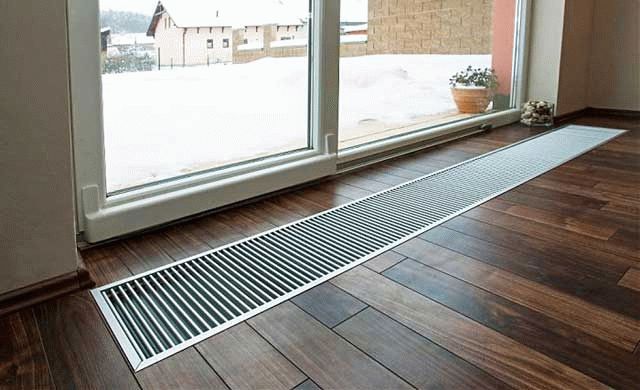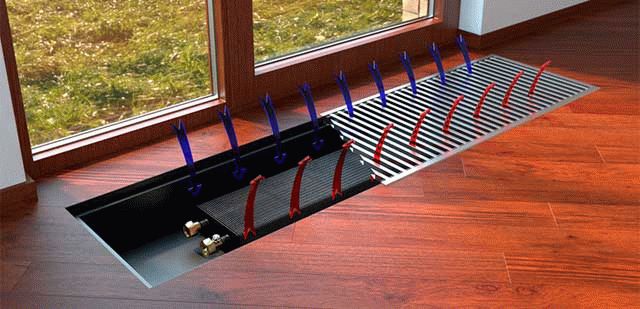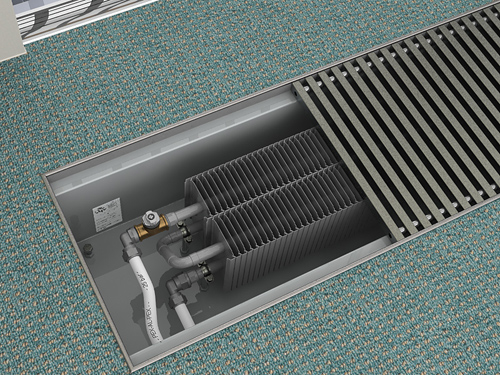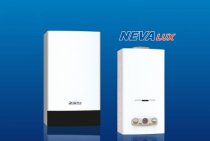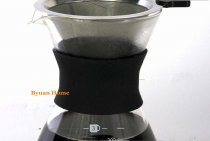Floor convector innovative solution for home heating
Heating systems are constantly evolving. The point is not only that traditional appliances are completely unsuitable for the design of modern housing, it is often simply impossible to use them in such conditions, for example, in rooms with a large area of panoramic glazing. Today we are witnessing the evolution of heating. A clear evidence of this are floor convectors - one of the best developments of recent decades in this area.
Floor convector, convenient and efficient heating system. The efficiency of such equipment exceeds 90%, moreover, this is a real opportunity for energy saving. The floor convector is placed in a special metal box. The latter is protected from corrosion, and on the inside it has a coating that reflects heat.
Operating principle
Floor radiators are conventional heating devices in which heat energy is transferred according to the principle of natural convection due to temperature differences. The air heated upon contact with the heater rises, giving way to the already cooled air at the surface of the floor covering. This continues in a circle: cold air is drawn into the box and, having warmed up from the heating convector, goes outside.
In a number of models (the so-called fan coil units) there are built-in fans that operate almost silently. Forced convection significantly accelerates and improves heating by blowing around the heat exchanger.
The built-in convector is built into the floor and closed with a model grill, flush with the floor covering, which in no way prevents the heated air from escaping. Built-in heating is also called design radiators, as they complement the interior of the room in an original way. Such equipment also removes any restrictions on the arrangement of furniture. In particular, they can be located in sufficient proximity to the battery in the floor.
Convection currents start their movement directly from the floor surface. This undoubtedly contributes to more efficient air mixing.
Built-in heating systems
Heating built into the floor must have a special recess in the floor. To do this, a niche is made before laying the floors. An electric convector or underfloor convectors for water heating are mounted in it. Such systems are widely used in houses with panoramic glass panels. They do not spoil the look of the interior of the rooms. The built-in heater, is closed by a decorative grid flush with a floor. This allows you to heat not only the room, but also doors and windows.
Underfloor water convectors are more economical than an electric unit built into the floor.
Materials for the manufacture of water heating systems are diverse. Heat-conducting properties of the metal from which the pipes and fins of the models are made:
- Iron - 47 W / Mk
- Brass - 111 W / Mk
- Aluminum - 236 W/Mk
- Copper - 390 W / Mk

Devices
Copper, have a greater thermal power. Combined options such as copper-aluminum (aluminum fins) or copper-brass (brass fins) have a lower cost. Although they are not inferior to copper in thermal conductivity. Iron water systems built into the floor are the cheapest. Their thermal power is significantly inferior to the listed specimens.
Electric convectors built into the floor are made of heating elements to which current is supplied. The heaters are usually protected by ceramic jackets. Heat-conducting metal plates are mounted on their body. They increase the heat transfer area.
Water heating convectors are built-in, they can have forced or natural air convection. With natural circulation, the heated air itself rises. It is pushed out by the cold lower layers of air.For forced convection, one or more small fans must be built in. They contribute to a more intensive exchange of air through the heater. This helps to heat the desired room faster. The fans are connected to an AC or DC power supply. Such devices are also equipped with electric convectors that are built into the floor.
Built-in heating can be equipped with temperature sensors that are connected to the smart home system. This helps to improve efficiency during operation.
Water
Convector floor water, can be used in the summer as an air conditioner. For such purposes, systems with four pipes are used. They are connected simultaneously to the heating and to the chiller (liquid cooler). Such models are called fan coil units.
In what cases are necessary
Water convectors are used to create a thermal curtain. A constant warm flow is used to limit the entry of cold air into the room and prevent drafts. The installation of heating convection modules built into the floor is advisable for rooms with panoramic windows and with a large number of external walls.

For the efficient operation of such devices, the ceiling height should not exceed 3 meters, since air flows heated by the heat exchanger create a comfortable temperature, they accumulate in the upper part of the room. The additional use of floor structures in conjunction with other types of heating systems provides a significant reduction in heat loss in houses with cold external walls.
Sub-series of the Oterm line from Warmann
As for the overall dimensions of the series models, the devices can have 18-, 23-, 30- and 37-cm widths, with 7.5-, 11- and 15-cm heights. The length of the heating channel is determined only by the needs of the consumer.
In addition to size, when choosing the optimal thermal equipment, you should also decide on its preferred type. There are several in the series.
Varmann Qtherm NK convectors are air-conditioning systems, whose price starts from 13,000 rubles, allowing not only to heat the room, but also to cool it. Devices of this sub-series are mounted in the floor surface near the panoramic windows or are built into under ordinary windows. They are able to ensure the flow of comfortable temperature air from the windows in the summer and enclose from the cold air flow in the fall and winter.
Qtherm HK Mini - in a case of almost miniature dimensions in devices of this subseries there is a highly efficient heat exchanger that operates in a 2-pipe system for supplying coolant and heat carrier, coupled with almost silent tangential fans capable of creating a truly uniform air flow. The cost of devices of such a plan starts from 24,000 rubles.
Qtherm Maxi is a water convector with high heat output due to large area fins on the heat exchanger and powerful fans. If the device is purchased for "wet" rooms, such as a bathroom, you can install it with a stainless steel case. The sizes of the Oterm Maxi models in their standard version are in the range of 75 - 325 cm in increments of 5 cm. The width can vary and be 19-, 25-, 31- and 37-cm, and the height is 15cm. The price for them starts from 23800 rubles.
Qtherm ECO are quite classic representatives of the series, equipped with tangential fans that provide forced convection. What distinguishes them is their compact size with increased heat output, attractive cost (from 19,200 rubles), low power consumption, quiet operation, a heat exchanger with a staggered tube arrangement and highly efficient heating of the plate.
Qtherm Electro - sub-series models are distinguished by the type of heating elements used. As you might guess, they are electric.Thus, such devices are able to function both without fan switching in natural convection mode, and as independent heat sources. The control system provides for an automated change in the level of heating of the electrical elements and regulation of the airflow.
Oterm Electro devices are produced in four sizes: 19-, 25-, 31- and 37-cm wide, 11-cm deep and any length. The price for them starts from 23200 rubles.
Qtherm Slim are the narrowest convectors among all Varmann heating devices. Can be used both vertically and horizontally, supplemented with 220V fans or fan units with 24V energy saving EC motors. In addition, such convectors can be equipped with a microprocessor high-speed fan rotation controller, which can operate both in manual mode and in tandem with wall controllers, and can also be connected to a “smart home” system. Their cost starts at 22,300 rubles (it grows in direct proportion to the length of the ordered structure).
Design and operational features Varmann Qtherm
The design of the convector of this model range includes: a steel case coated with a wear-resistant black dye (the device becomes inconspicuous under the grille), a removable heat exchanger, fans in a casing with motors and a device that regulates their operation, a decorative grille that can be painted in any shade and even acquire a texture that imitates stone, wood, etc., as well as a rubber strip under the grate, which reduces the noise from the operating device.
An important design feature of the series models is a tangential fan, which is powered by 12 or 220 volts. It stands inside in such a way that the cold air flow from the window or doorway is carried along the device
Being powered by a twelve-volt network, such fans demonstrate amazing energy savings - up to eighty percent (compared to those powered by 220V)! It is worth noting that the thermal power of Qtherm devices is highly dependent on the fan speed.
The air supply system of the convector enables high-precision and smooth adjustment of the blowing intensity by means of a microprocessor-based automatic rotational frequency controller. If the temperature differences inside and outside are insignificant, the system can also function in fanless mode - solely due to convection heating.
Adjustment of Varman's "Otherms" settings is made by internal microprocessors. However, it can be performed manually, as well as through the Smart Home electrical system.
Due to the use of copper-aluminum components in the production, the brand's climate equipment boasts a long service life of decades, resistance to corrosion, as well as excellent thermal conductivity and space heating for any purpose.
